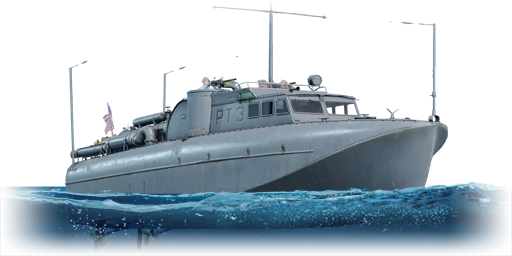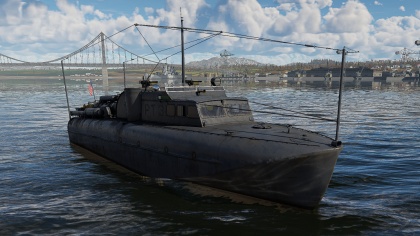Difference between revisions of "PT-3"
CobraKingII (talk | contribs) (→History) (Tag: Visual edit) |
(Cutting history into multiple paragraph and some minor edits.) |
||
| Line 48: | Line 48: | ||
<!-- ''Describe the history of the creation and combat usage of the ship in more detail than in the introduction. If the historical reference turns out to be too big, take it to a separate article, taking a link to an article about the vehicle and adding a block "/ History" (example: <nowiki>https://wiki.warthunder.com/(Vehicle-name)/History</nowiki>) and add a link to it here using the <code>main</code> template. Be sure to reference text and sources by using <code><nowiki><ref></nowiki></code>, as well as adding them at the end of the article.'' --> | <!-- ''Describe the history of the creation and combat usage of the ship in more detail than in the introduction. If the historical reference turns out to be too big, take it to a separate article, taking a link to an article about the vehicle and adding a block "/ History" (example: <nowiki>https://wiki.warthunder.com/(Vehicle-name)/History</nowiki>) and add a link to it here using the <code>main</code> template. Be sure to reference text and sources by using <code><nowiki><ref></nowiki></code>, as well as adding them at the end of the article.'' --> | ||
| − | '''''PT-3''''' was layed down on August 1, 1939 by Fisher Boat Works in Detroit, Michigan. It was launched on April 18, 1940 | + | '''''PT-3''''' was layed down on August 1, 1939 by Fisher Boat Works in Detroit, Michigan. It was launched on April 18, 1940 and it was completed on June 20 of the same year. It entered service on July 24 and it was assigned to Motor Torpedo Boat Squadron ONE (PTRon 1) to be evaluated. |
| + | |||
| + | PTRon 1 was the first squadron of its kind, and it was a squadron of experimental ships when it was created and was under the command of Lt. Earl S. Caldwell, USN. It was to be given to the Royal Navy on April 19, 1942 and would have been re-designated as the '''''HM MTB-273'''''. However, the transfer was cancelled and was instead transferred to the Royal Canadian Air Force (RCAF) with the designation '''''Bras D'Or (M 413)'''''. It was intended to be used as a high speed rescue launch boat. | ||
| + | |||
| + | Following its service in the war, it was was returned to the US on April 10, 1945 and once again re-designated, this time as the '''''B-119'''''. The last transfer in its long and storied history was between the United States Navy (USN) to the War Shipping Administration on May 2, 1946. | ||
| + | |||
| + | It still survives today in rather poor condition and can be found at Flanigan Brothers Boatyard, Fairton, NJ (as of 2012), waiting to be restored. | ||
| + | |||
| + | The ship historically had a displacement of 25 t, a length of 58 ft, and a beam of 18 ft. It was powered by two 1,350 hp Packard gasoline engines, and had two shafts. The armament consisted of two .50 cal machine guns, two 18 inch Mk. 7 torpedoes, and two Mk. 6 depth charge racks. | ||
== Media == | == Media == | ||
Revision as of 05:20, 23 May 2020
Contents
Description
The 58 ft PT-3 is a premium rank I American motor torpedo boat
with a battle rating of 1.0 (AB/RB/SB). It was introduced in Update 1.83 "Masters of the Sea" as part of the release of fleet into open beta test.
General info
Survivability and armour
Talk about the vehicle's armour. Note the most well-defended and most vulnerable zones, e.g. the ammo magazine. Evaluate the composition of components and assemblies responsible for movement and manoeuvrability. Evaluate the survivability of the primary and secondary armament separately. Don't forget to mention the size of the crew, which plays an important role in fleet mechanics. Tips for preserving survivability should be saved for the "Use in battle" section.
If necessary, use a graphic template to show the most well-protected or most vulnerable points in the armour.
Mobility
Write about the ship’s mobility. Evaluate its power and manoeuvrability, rudder rerouting speed, stopping speed at full tilt, with its maximum forward speed and reverse speed.
Armament
Primary armament
Provide information about the characteristics of the primary armament. Evaluate their efficacy in battle based on their reload speed, ballistics and the capacity of their shells.
Broadly describe the ammunition available for the primary armament, and provide recommendations on how to use it and which ammunition to choose.
Torpedo armament
Many ships are armed with torpedo launchers, and for some vessels such as boats, torpedoes are an extremely important means of defeating an opponent. Evaluate the position of the torpedo launchers, discuss the ammunition available, firing specifics such as dead zones, features of the torpedoes themselves, etc.
Special armament
Depth charges, mines, rocket launchers and missiles are also effective in skilled hands and can be an unexpected surprise for an opponent. Evaluate the ammunition of this type of armament and rate its performance in combat.
Usage in battles
Describe the technique of using this ship, the characteristics of her use in a team and tips on strategy. Abstain from writing an entire guide – don’t get try to provide a single point of view, but give the reader food for thought. Talk about the most dangerous opponents for this vehicle and provide recommendations on fighting them. If necessary, note the specifics of playing with this vehicle in various modes (AB, RB, SB).
Pros and cons
Summarize and briefly evaluate the vehicle in terms of its characteristics and combat effectiveness. Mark its pros and cons in the bulleted list. Try not to use more than 6 points for each of the characteristics. Avoid using categorical definitions such as "bad", "good" and the like - they have a substitution in the form of softer "inadequate", "effective".
Pros:
Cons:
History
PT-3 was layed down on August 1, 1939 by Fisher Boat Works in Detroit, Michigan. It was launched on April 18, 1940 and it was completed on June 20 of the same year. It entered service on July 24 and it was assigned to Motor Torpedo Boat Squadron ONE (PTRon 1) to be evaluated.
PTRon 1 was the first squadron of its kind, and it was a squadron of experimental ships when it was created and was under the command of Lt. Earl S. Caldwell, USN. It was to be given to the Royal Navy on April 19, 1942 and would have been re-designated as the HM MTB-273. However, the transfer was cancelled and was instead transferred to the Royal Canadian Air Force (RCAF) with the designation Bras D'Or (M 413). It was intended to be used as a high speed rescue launch boat.
Following its service in the war, it was was returned to the US on April 10, 1945 and once again re-designated, this time as the B-119. The last transfer in its long and storied history was between the United States Navy (USN) to the War Shipping Administration on May 2, 1946.
It still survives today in rather poor condition and can be found at Flanigan Brothers Boatyard, Fairton, NJ (as of 2012), waiting to be restored.
The ship historically had a displacement of 25 t, a length of 58 ft, and a beam of 18 ft. It was powered by two 1,350 hp Packard gasoline engines, and had two shafts. The armament consisted of two .50 cal machine guns, two 18 inch Mk. 7 torpedoes, and two Mk. 6 depth charge racks.
Media
An excellent addition to the article will be video guides, as well as screenshots from the game and photos.
See also
Links to the articles on the War Thunder Wiki that you think will be useful for the reader, for example:
- reference to the series of the ship;
- links to approximate analogues of other nations and research trees.
External links
Paste links to sources and external resources, such as:
- topic on the official game forum;
- encyclopedia page on ship;
- other literature.
| USA boats | |
|---|---|
| Motor torpedo boats | PT-3 · PT-6 · PT-20 · PT-71 · PT-103 · PT-109 · PT-174 |
| PT-200 · PT-314 · Thunderbolt (PT-556) · PT-565 · PT-658 · PT-810 · PT-811 · PT-812 | |
| Motor gun boats | Kim Qui · LCS(L)(3) · PT-59 · PTF-7 · USS Candid · USS Asheville · USS Douglas · USS Flagstaff · USS Tucumcari · USS Cyclone |
| Armoured gun boats | LCM(6) Zippo |
| USA premium ships | |
|---|---|
| Motor torpedo boats | PT-3 · PT-109 · PT-174 · Thunderbolt (PT-556) · PT-658 · PT-811 |
| Motor gun boats | LCM(6) Zippo · USS Douglas · USS Flagstaff |
| Sub-chasers | Carmi (PC-466) |
| Destroyers | USS Welborn C. Wood · USS Wilkinson · USS Bennion · USS Cowell · USS Davis · USS Moffett · USS Phelps · USS Frank Knox |
| Light cruisers | USS Detroit · USS Helena |
| Heavy cruisers | USS Des Moines |
| Battleships | USS Arkansas |





